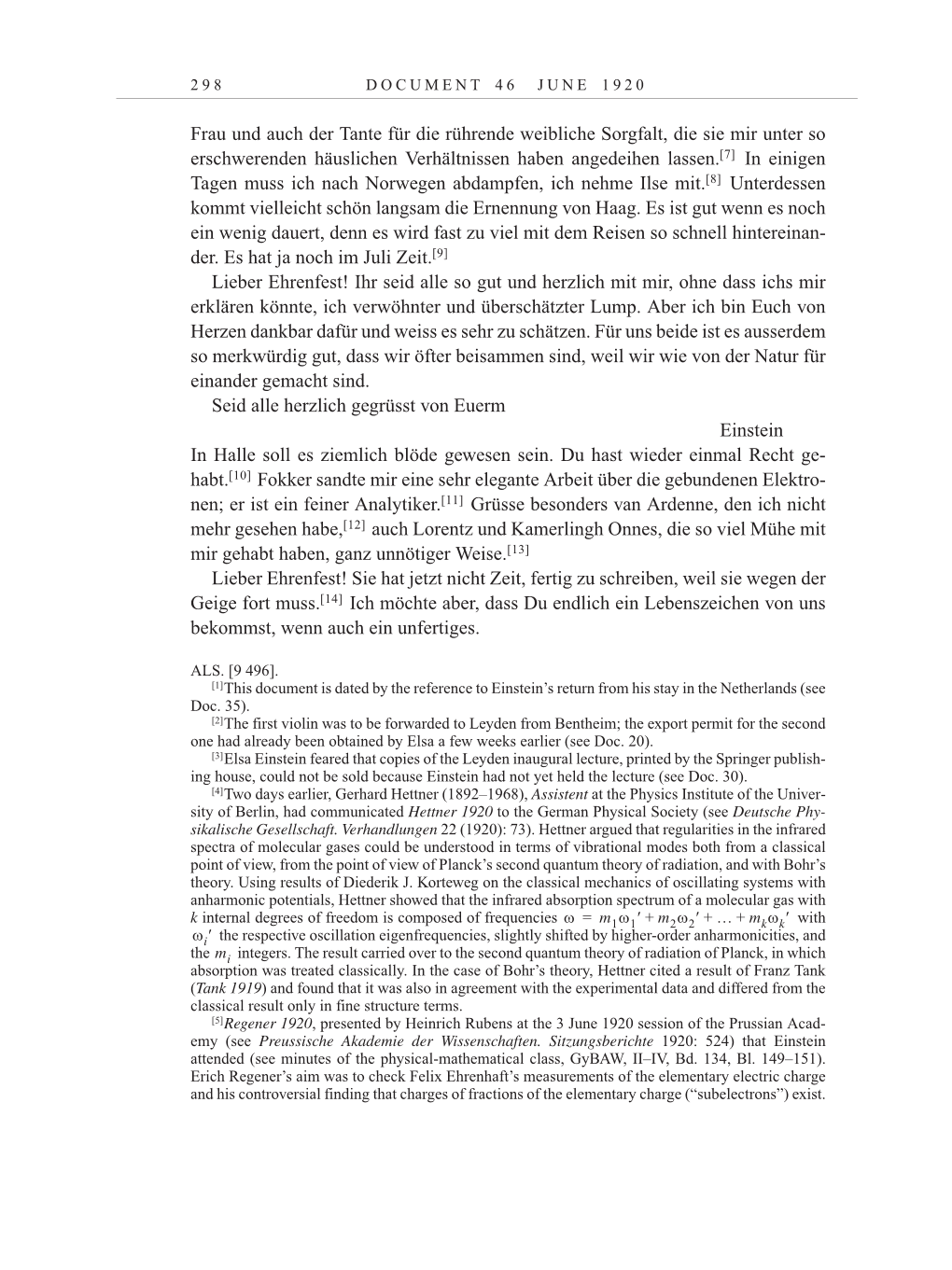2 9 8 D O C U M E N T 4 6 J U N E 1 9 2 0
Frau und auch der Tante für die rührende weibliche Sorgfalt, die sie mir unter so
erschwerenden häuslichen Verhältnissen haben angedeihen
lassen.[7]
In einigen
Tagen muss ich nach Norwegen abdampfen, ich nehme Ilse
mit.[8]
Unterdessen
kommt vielleicht schön langsam die Ernennung von Haag. Es ist gut wenn es noch
ein wenig dauert, denn es wird fast zu viel mit dem Reisen so schnell hintereinan-
der. Es hat ja noch im Juli
Zeit.[9]
Lieber Ehrenfest! Ihr seid alle so gut und herzlich mit mir, ohne dass ichs mir
erklären könnte, ich verwöhnter und überschätzter Lump. Aber ich bin Euch von
Herzen dankbar dafür und weiss es sehr zu schätzen. Für uns beide ist es ausserdem
so merkwürdig gut, dass wir öfter beisammen sind, weil wir wie von der Natur für
einander gemacht sind.
Seid alle herzlich gegrüsst von Euerm
Einstein
In Halle soll es ziemlich blöde gewesen sein. Du hast wieder einmal Recht ge-
habt.[10]
Fokker sandte mir eine sehr elegante Arbeit über die gebundenen Elektro-
nen; er ist ein feiner
Analytiker.[11]
Grüsse besonders van Ardenne, den ich nicht
mehr gesehen
habe,[12]
auch Lorentz und Kamerlingh Onnes, die so viel Mühe mit
mir gehabt haben, ganz unnötiger
Weise.[13]
Lieber Ehrenfest! Sie hat jetzt nicht Zeit, fertig zu schreiben, weil sie wegen der
Geige fort
muss.[14]
Ich möchte aber, dass Du endlich ein Lebenszeichen von uns
bekommst, wenn auch ein unfertiges.
ALS. [9 496].
[1]This document is dated by the reference to Einstein’s return from his stay in the Netherlands (see
Doc. 35).
[2]The first violin was to be forwarded to Leyden from Bentheim; the export permit for the second
one had already been obtained by Elsa a few weeks earlier (see Doc. 20).
[3]Elsa Einstein feared that copies of the Leyden inaugural lecture, printed by the Springer publish-
ing house, could not be sold because Einstein had not yet held the lecture (see Doc. 30).
[4]Two days earlier, Gerhard Hettner (1892–1968), Assistent at the Physics Institute of the Univer-
sity of Berlin, had communicated Hettner 1920 to the German Physical Society (see Deutsche Phy-
sikalische Gesellschaft. Verhandlungen 22 (1920): 73). Hettner argued that regularities in the infrared
spectra of molecular gases could be understood in terms of vibrational modes both from a classical
point of view, from the point of view of Planck’s second quantum theory of radiation, and with Bohr’s
theory. Using results of Diederik J. Korteweg on the classical mechanics of oscillating systems with
anharmonic potentials, Hettner showed that the infrared absorption spectrum of a molecular gas with
k internal degrees of freedom is composed of frequencies with
the respective oscillation eigenfrequencies, slightly shifted by higher-order anharmonicities, and
the integers. The result carried over to the second quantum theory of radiation of Planck, in which
absorption was treated classically. In the case of Bohr’s theory, Hettner cited a result of Franz Tank
(Tank 1919) and found that it was also in agreement with the experimental data and differed from the
classical result only in fine structure terms.
[5]Regener 1920, presented by Heinrich Rubens at the 3 June 1920 session of the Prussian Acad-
emy (see Preussische Akademie der Wissenschaften. Sitzungsberichte 1920: 524) that Einstein
attended (see minutes of the physical-mathematical class, GyBAW, II–IV, Bd. 134, Bl. 149–151).
Erich Regener’s aim was to check Felix Ehrenhaft’s measurements of the elementary electric charge
and his controversial finding that charges of fractions of the elementary charge (“subelectrons”) exist.
m1
1
m2
2
mk
k
+ + + =
i
mi
